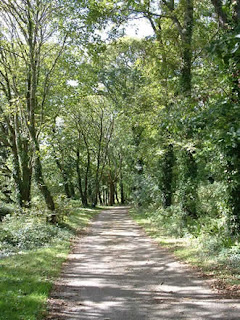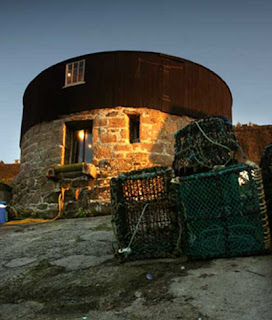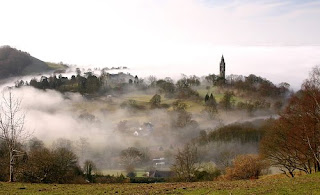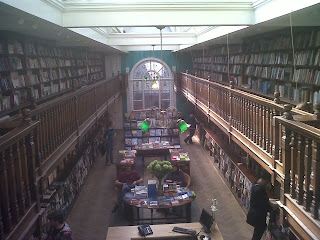And so was the hotel. The Elms was originally built in 1710 and rebuilt following a fire in 1927 which left only the front walls of the house standing. It is a magnificently grand, stone property with a imposing central staircase and domed stained-glass skylight. With the room not ready for a few hours and our two girls fast asleep in the car, we ditched the cases and decided to take a drive to Worcester, about ten miles away.
 Source: MJA Smith
Source: MJA SmithGoing to Worcester was a big disappointment. In spite of the bright sunshine, which in most cases can render even the most ugly topography positively, the town has an absence of character. There are some nice buildings, most notably the Guildhall (whose architect, Thomas White, a Wren pupil, also designed The Elms), and the cathedral has an obvious draw, but the main streets are filled with the usual high street names as well as poor quality independents; there is also an abundance of buildings of unsympathetic and dated design, which to my mind have destroyed the basic character of what should be a pretty county town. After a thoroughly depressing lunch in Marks & Spencer where all the patrons seemed to just want to moan and gripe about illness and the poor state of everything, we decided to leave before we too started feeling miserable. We chanced upon a shop called New England Country Store on which was filled with cute home-ware products from the likes of Cath Kidston and Poppy Treffry, spent a small fortune, and decided to head back to The Elms.
Whether it was the disappointment of spending time in Worcester or a residual disappointment that we should have, at that time, been sat round a pool in Quinta do Lago in Portugal, but when we reached our room we weren't terribly impressed. We had selected an 'executive' room, as this was what was described as being most suitable for two adults and two children. The practicalities of the space, however, made movement around the room nigh on impossible. Daughter#2's travel cot only had one possible home, which was in front of the wardrobe, making it difficult to open, while Daughter#1's camp bed lay along the width of our bed, further reducing the space which was pretty limited to start with. The other thing, which is completely out of the control of the hotel, is that the furnishings are befitting of a period property; given that we favour, and are accustomed to, modernity, it took a while to adjust to this form of 'luxury'. All of this said, we swiftly climbed out of this funk and I can honestly say it was the only low point in that whole week.
One of the reasons was because The Elms has a superb, modern kids' club called the Bears' Den; I've always been quite reticent about putting our girls into these types of places, and Daughter#2 – at two – is generally too young for most crèches like this. Not at The Elms, where Ewa, Vicky and Sue had the pleasure of our children's company while we took a lovely afternoon tea (with the hotel's own delicious Abberley tea blend) each of the three days we were there. The girls loved the Bears' Den and were crushed when they had to leave.
Also modern is the Aquae Sulis spa, which has no restrictions on the times kids can use the pool, so the girls loved that. Mrs S took herself off for a massage one day, while I sat in the sun on the terrace doing some writing. I found the whole set-up really conducive to relaxing and unwinding, which I duly did. The gardens at The Elms are lovely also, and unlike other grand houses, aren't off limits for curious kids. In addition to a large sloping lawn, there's a secret garden, play area and tennis courts.
Service wise, across the stay we did receive some little inconsistencies from one day to the next, most of which were just minor irritations more than anything else. Getting peas with the kids' fish and chips meal one day and not getting them the next; having a slice of cucumber in my Hendricks and tonic one day and not the next; getting talked through the breakfast buffet and egg options each of the three days, by the same waiter, in a hotel with fewer than 30 rooms even though he recognised us and acknowledged me by name; signing for our meal in the Pear Terrace on the last night and realising that we hadn't signed for anything else the entire time we were there. That sort of thing. Whilst nothing individually disastrous, they were basics we expected a £300 per night hotel to get right without making us even notice them.
On the Friday we took a drive to Great Malvern, with the intention of walking into the hills. That didn't happen, mainly because we spent so much time wandering, slack-jawed, around the town itself, marvelling at how well preserved the town is, and also at how well it has maintained – mostly – a focus on independent retailers (Worcester take note). Even a high street chain like WHSmith has been here, in the same spot, for decades and retains features from yesterday such as the mosaic picture below. We bought bits and pieces for the house from Ipaetus Gallery and had a picnic in the serene Rose Bank gardens, marvelling at the views across the Midlands and the cascading town tiered below us. I think it's fair to say that I did rather fall for Malvern in a big way that day.
 Source: MJA Smith
Source: MJA SmithThe following day we headed for the Cotswolds, an area I seldom visited enough as a child but where I have had many, many happy times with Mrs S since. We started our mini-tour at Broadway, spending far too much time and money at Cotswold Trading until the pull of having a cup of tea in the sunshine outside The Broadway Hotel was too great. From there we drove through the countryside to Bourton-on-the-Water (cheating slightly here as it's in Gloucestershire), possibly unwise given its status as a tourist hotspot; we were also running out of time, so literally stopped there for lunch at The Croft, where we sat on their sun-drenched terrace and observed the combination of arty types and foreign holidaymakers passing by. The Croft has a really good, simple menu, and also offers good, healthy choices for kids.
The following day, after checking out, we drove along the road to Witley Court, a ruined house and lakeside garden destroyed by fire in the 1920s (was burning down the house a past-time on this stretch of road in the early part of the last Century I wonder?). Managed by English Heritage, I found the sight of an historic property gutted by flames strangely moving, while the girls loved the adventure of exploring the hollowed-out rooms, spotting the fireplaces halfway up walls where formerly the upper storeys would have been. To add insult to the house's injury, prior to the fire, all of the major fittings and fixtures were stripped and sold by the then owners.
 Source: Google Images search
Source: Google Images searchOne of the core attractions of Witley Court is its fountains. To complete this sad tale of a mournful building, the piping used to pump water to the main fountain was removed during the second World War, presumably to be melted down for weaponry. Since refurbished, the fountain is now in full working order and is demonstrated at set intervals in the day; the central plume of water is capable of shooting a majestic 100ft into the air. No trip to an historic property would be complete without a trip to the tea shop, which is here attached to the remarkably-undamaged church which adjoins the main Witley Court house. Fine home-made cakes and scones ensued before setting off for home.
That completed the second leg of our staycation. It left me feeling like we'd only scratched the surface of Worcestershire's rich spoils, but at least it managed to redefine my – false – impressions of the county. Thank you, Eyjafjallajökull for serendipitously allowing that to happen.
































